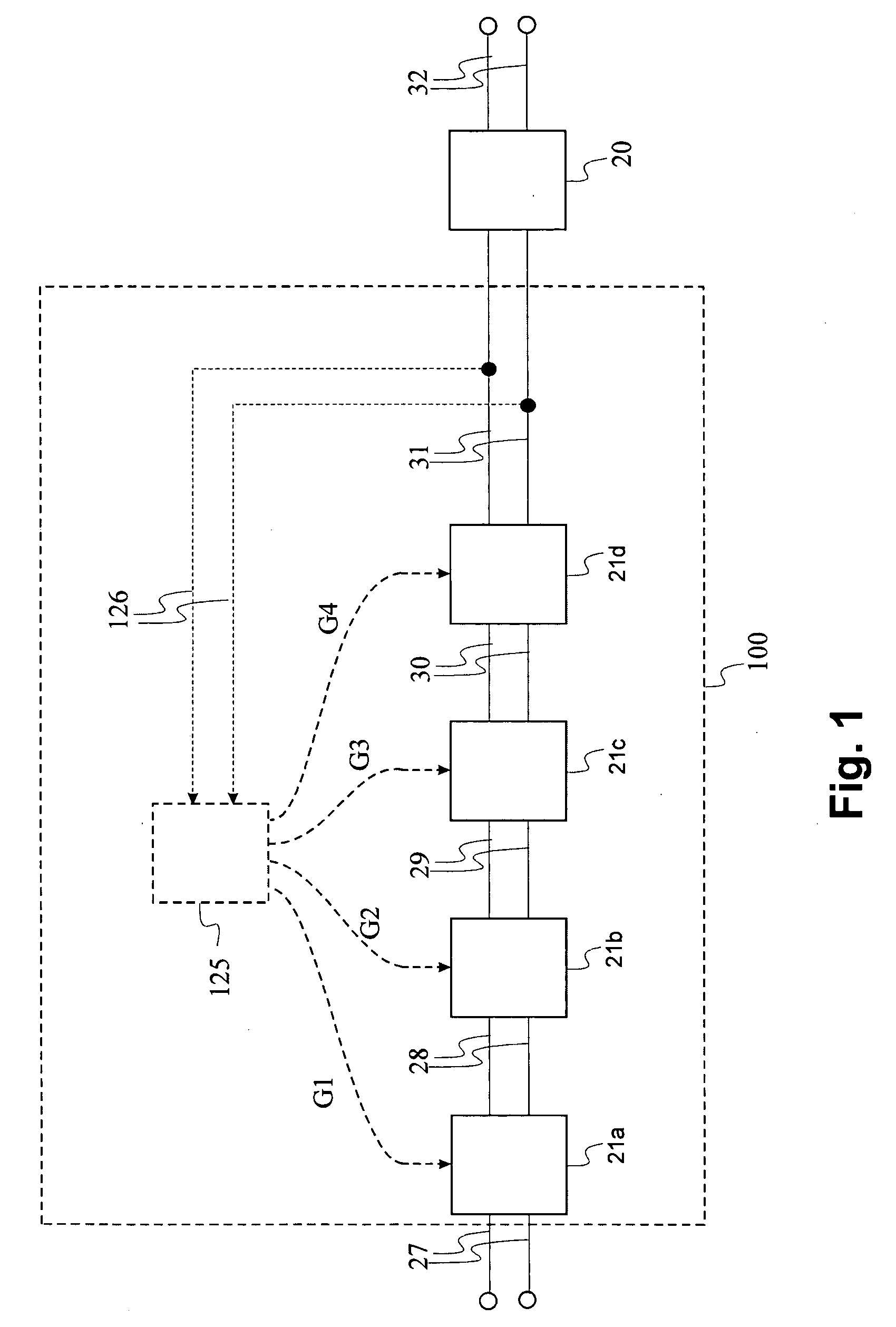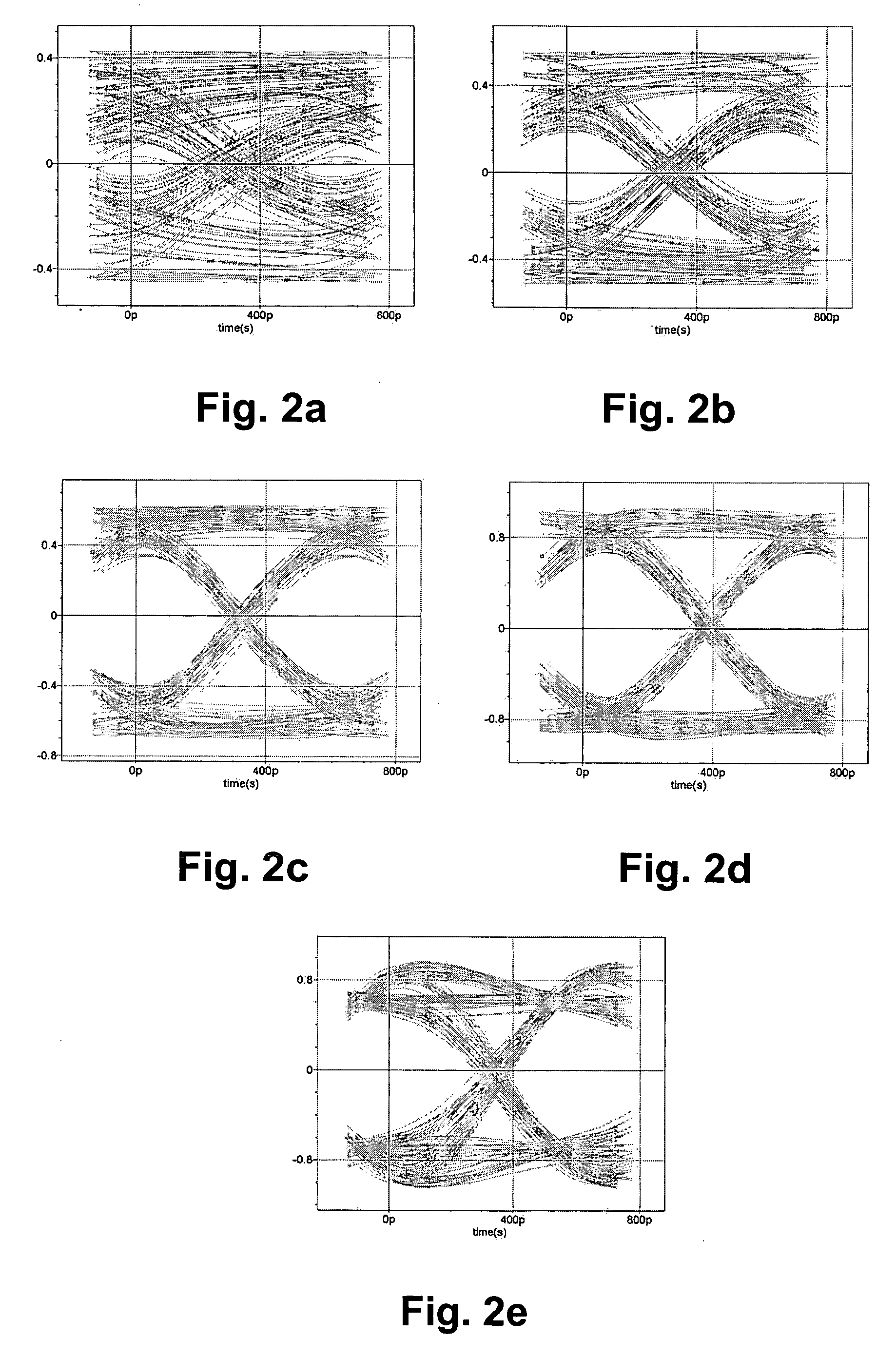Multistage tuning-tolerant equalizer filter
a multi-stage, equalizer filter technology, applied in the field of data communication, can solve the problems of not being suited for low voltage operation nor small chip area implementation, not being able to achieve low-voltage operation, etc., to achieve enhanced tuning tolerance, improve the robustness and data-restoration capability of equalizer filters, and improve the effect of high frequency attenuation behaviour
- Summary
- Abstract
- Description
- Claims
- Application Information
AI Technical Summary
Benefits of technology
Problems solved by technology
Method used
Image
Examples
first embodiment
[0071] In a first embodiment, the invention relates to an equalizer filter 100 as schematically shown in FIG. 1 which achieves an allowable overcompensation with a limited amount of jitter. Jitter is the unwanted variations of a binary signal's leading and trailing edges. It occurs as the signal is processed or transmitted over a transmission channel from one point to another. Jitter also is a time displacement, either periodic or random, of a signal's switching edges. Excessive jitter always increases the bit-error rate (BER) in the transmission system. As a result, most serial data-communications systems have jitter standards that must be met to ensure robust performance and the quality of service (QoS) expected in today's networks. The filter may be used in a suitable electronic device, e.g. in a modem or receiver of a telecommunications device.
[0072] The equalizer filter 100 shows a cascade of amplifying compensation stages 21a, 21b, 21c, 21d of a multi-stage equalizer system. T...
third embodiment
[0080] In a third embodiment, the invention relates to a wide range self-adaptive equalizer filter 500. The wide range self-adaptive equalizer filter 500, as shown in FIG. 7 is very robust. The equalizer filter 500 comprises the same components and features of an equalizer filter 100, 300, 400 according to any of the previous embodiments, but the equalizer filter 500 furthermore comprises a second feed-back loop for self adaptation. This second feed-back loop comprises a feed-back circuit 502 and a feed-back connection 504 between an intermediate node 28, 29, 30, 31 positioned after an amplification compensation stage, preferably after the last amplification compensation stage 21d, and the feed-back circuit 502. The feed-back circuit 502 preferably sequentially turns on amplifying compensation stages 21a to 21d until typically matched compensation is reached. For matched compensation typically an error margin of about 1 to 2 dB, depending on the level of compensation and compensatio...
fourth embodiment
[0081] In a fourth embodiment, the invention relates to a self-adaptive equalizer filter 600 as shown in FIG. 8, wherein a large overcompensation is allowed. The equalizer filter 600 comprises the same components and has the same features of the self-adaptive equalizer filters shown in the previous embodiments, but furthermore, the input signal at input node 27 of the equalizer filter 600 is measured and fed to a feed-forward circuit 602 through feed-forward connection 604. Depending on the amplitude or power of this input signal, feed-forward circuit 602 can determine how many of the available amplifying compensation stages 21a, 21b, 21c, 21d will be turned on and will show higher frequency gain. The achievable higher frequency gain with this system is similar as with the previously described system. Due to the presence of hysteresis in the present equalizer filter 600 having a feed-forward circuit 602, the stability of the system will be improved.
PUM
 Login to View More
Login to View More Abstract
Description
Claims
Application Information
 Login to View More
Login to View More - R&D
- Intellectual Property
- Life Sciences
- Materials
- Tech Scout
- Unparalleled Data Quality
- Higher Quality Content
- 60% Fewer Hallucinations
Browse by: Latest US Patents, China's latest patents, Technical Efficacy Thesaurus, Application Domain, Technology Topic, Popular Technical Reports.
© 2025 PatSnap. All rights reserved.Legal|Privacy policy|Modern Slavery Act Transparency Statement|Sitemap|About US| Contact US: help@patsnap.com



